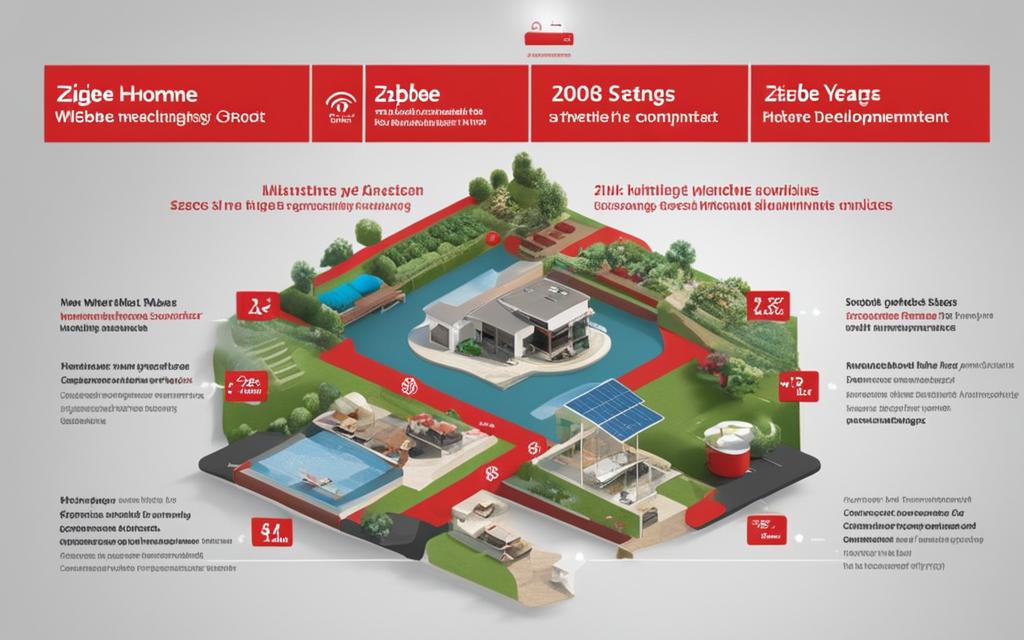Zigbee Networks play a pivotal role in driving efficient connectivity for smart home and IoT solutions. With the increasing demand for lower utility bills and energy efficiency, wireless communication protocols like Zigbee provide the ideal solution for managing home appliances and HVAC units remotely.
Zigbee, based on IEEE 802.15.4 standards, offers advantages such as low power requirements, lighting control, single-touch operation, multi-source capabilities, and enhanced security attributes for home automation.
Advantages of Zigbee in Home Automation
Zigbee is an ideal choice for communication in home networks due to its small, low-power, and low data rate digital radios. The technology offers numerous advantages that contribute to seamless home automation.
Lighting Control and Low Power Requirements
With Zigbee, homeowners can easily control their lighting systems. Whether it’s dimming the lights or adjusting the color temperature, Zigbee provides the flexibility to create the perfect ambiance, all while ensuring low power consumption. This not only reduces energy costs but also promotes sustainability.
Wireless Control of Domestic Appliances
One of the significant benefits of Zigbee is the ability to control various domestic appliances through a wireless network. From managing smart thermostats to controlling home entertainment systems, Zigbee allows users to conveniently operate their devices from anywhere within their home.
Integration into a Single Control Unit
Zigbee enables the integration of all devices into a single control unit, making it easier for homeowners to manage and monitor their smart home systems. This centralized control allows for a seamless user experience and eliminates the need for managing multiple apps or interfaces.
Enhanced Security Features
Zigbee’s security features, provided by the IEEE 802.15.4 MAC sub-layer, ensure that your home automation system remains secure. With robust encryption and authentication mechanisms, Zigbee protects against unauthorized access and provides peace of mind.
Scalable Network Management
Zigbee allows for the management of up to 254 nodes from a single remote control. This scalability ensures that homeowners can expand their network and add new devices without any hassle. Whether it’s controlling smart locks, sensors, or smart plugs, Zigbee offers the flexibility to accommodate an ever-growing ecosystem of IoT devices.
In conclusion, Zigbee’s advantages in home automation make it a preferred choice for homeowners looking to transform their house into a smart home. From lighting control and wireless appliance management to enhanced security and scalable network management, Zigbee simplifies and enhances the automation of various tasks, providing convenience, energy efficiency, and improved overall living experiences.
Zigbee and Smart Home Connectivity: Emerging Trends
Zigbee technology is revolutionizing the smart home industry by enabling seamless connectivity among various smart devices. As the demand for smarter and more connected homes continues to grow, several emerging trends in Zigbee and smart home connectivity are shaping the future of the industry.
Enhanced Interoperability
One of the key trends in Zigbee and smart home connectivity is the focus on enhanced interoperability. Zigbee devices are becoming increasingly compatible with other smart home platforms and protocols. This interoperability allows users to connect and control devices from different manufacturers, creating a unified and streamlined smart home experience.
Integration with Voice Assistants
Zigbee’s integration with voice assistants, such as Amazon Alexa and Google Assistant, is another significant trend. Voice control is becoming increasingly popular in smart homes, allowing users to effortlessly control their devices through simple voice commands. With Zigbee’s compatibility with voice assistants, users can enjoy a hands-free and convenient smart home experience.
Energy Efficiency with Longer Battery Life
Energy efficiency is a crucial consideration in smart home connectivity. Zigbee devices are designed to be energy-efficient, allowing for longer battery life and reducing the need for frequent battery replacements. This trend ensures that smart devices can operate reliably and efficiently, contributing to a sustainable and eco-friendly smart home environment.
Mesh Networking for Reliability
Zigbee utilizes a mesh networking architecture, which improves the reliability of smart home connectivity. Each Zigbee device acts as a node, relaying signals to other devices, creating a robust and resilient network. This mesh network ensures that even if one device fails or is out of range, the network can still function smoothly, enhancing the overall reliability of smart home systems.
Compatibility with 5G Networks
As the deployment of 5G networks progresses, compatibility with this next-generation technology has become an emerging trend in smart home connectivity. Zigbee’s compatibility with 5G networks allows for faster and more stable communication between devices, enabling seamless connectivity and unlocking new possibilities for smart home applications.
Enhanced Security Features
Security is a top priority in smart home connectivity, and Zigbee addresses this concern through enhanced security features. Zigbee devices are equipped with robust encryption protocols, ensuring secure communication and protecting sensitive user data. This trend provides users with peace of mind and confidence in the security of their smart home systems.
A Growing Device Ecosystem
The Zigbee ecosystem is constantly expanding, with a wide range of devices available for smart home integration. From smart bulbs and thermostats to door locks and security systems, there is a growing selection of Zigbee-compatible devices to suit various needs and preferences. This trend offers users the flexibility to choose from a diverse range of devices and customize their smart home setup.
The Rise of DIY Smart Home Solutions
With the increasing accessibility and user-friendly nature of Zigbee technology, do-it-yourself (DIY) smart home solutions are gaining popularity. DIY enthusiasts and homeowners can easily set up and expand their smart home systems using Zigbee devices. This trend empowers users to take control of their smart home journey and tailor their automation to their specific requirements.
| Trend | Description |
|---|---|
| Enhanced Interoperability | Zigbee devices are becoming more compatible with other smart home platforms and protocols, allowing for seamless connectivity between devices from different manufacturers. |
| Integration with Voice Assistants | Zigbee devices can be easily integrated with popular voice assistants like Amazon Alexa and Google Assistant, enabling voice control capabilities in smart homes. |
| Energy Efficiency with Longer Battery Life | Zigbee devices are designed to be energy-efficient, resulting in longer battery life and reduced environmental impact. |
| Mesh Networking for Reliability | Zigbee’s mesh networking architecture ensures reliable connectivity by allowing devices to relay signals, creating a robust network that can adapt to device failures or range limitations. |
| Compatibility with 5G Networks | Zigbee devices can seamlessly integrate with 5G networks, providing faster and more stable communication for smart home systems. |
| Enhanced Security Features | Zigbee devices incorporate advanced security protocols to protect user data and ensure the privacy of smart home systems. |
| A Growing Device Ecosystem | Zigbee offers a wide variety of compatible devices, allowing users to choose from an extensive selection of smart home products. |
| The Rise of DIY Smart Home Solutions | Zigbee’s user-friendly nature has led to an increase in DIY smart home solutions, empowering users to take control of their automation projects. |
These emerging trends in Zigbee and smart home connectivity contribute to the widespread adoption of Zigbee in the smart home industry. With its flexibility, reliability, and ability to improve user experiences, Zigbee continues to shape the future of connected homes, creating smarter and more convenient living environments.
The Origins and Development of Zigbee
Zigbee, a wireless communication protocol, originated from the IEEE 802.15.4 standard and was developed in the late 1990s as a cost-effective and simple alternative to Wi-Fi and Bluetooth technologies.
The Zigbee Alliance, founded in 2002, played a crucial role in promoting the adoption of Zigbee and fostering the growth of the Internet of Things (IoT). Its primary objectives were to simplify and harmonize IoT deployments, promote the usage of Zigbee, and distribute application profiles for IoT products.
“Zigbee Alliance aims to simplify and harmonize IoT deployments, promote the usage of Zigbee, and distribute profiles that allow Zigbee-based products to work together seamlessly.” – Zigbee Alliance
In 2021, the Zigbee Alliance rebranded itself as the Connectivity Standards Alliance (CSA) to reflect its expanded mission. As part of this transition, the alliance introduced the Matter brand, formerly known as Project CHIP (Connected Home over IP). This rebranding aims to advance connectivity standards, signify reliability, security, and compatibility, and create a unified smart home ecosystem.
Zigbee’s Evolution: Key Milestones
- 1998: Zigbee’s development begins as a low-cost, low-power wireless communication solution.
- 2002: The Zigbee Alliance is established to promote Zigbee technology and drive IoT adoption.
- 2004: The first Zigbee specification, Zigbee 1.0, is released, enabling interoperability among Zigbee devices.
- 2011: Zigbee PRO, an enhanced version of Zigbee, is introduced, offering improved scalability and security.
- 2021: The Zigbee Alliance rebrands as the Connectivity Standards Alliance (CSA) and introduces the Matter brand, emphasizing reliability, security, and compatibility.
Throughout its development, Zigbee has evolved to meet the growing demands of the IoT industry, offering a robust and reliable wireless communication solution for various smart home and IoT applications.

Zigbee’s Impact on IoT and Smart Home
With its humble beginnings as an alternative to Wi-Fi and Bluetooth, Zigbee has played a significant role in enabling efficient connectivity for smart home and IoT solutions. The protocol’s low power requirements, enhanced security features, and ability to integrate multiple devices into a single control unit make it an ideal choice for home automation.
Zigbee’s development and the emergence of the Connectivity Standards Alliance (CSA) signify the continuous evolution of the protocol to better serve the needs of the IoT industry. As the smart home ecosystem continues to expand, Zigbee remains a key player, driving seamless device integration and enhancing user experiences in the connected world.
Zigbee Protocol in Wireless IoT Networks: Devices and Structure
Zigbee plays a crucial role in the operation of wireless IoT networks, connecting devices and facilitating seamless communication and data exchange. Utilizing low-power mesh networking, Zigbee enables efficient connectivity and ensures reliable data transfer among connected devices. With its robust structure and versatile capabilities, Zigbee is widely deployed in various applications within the IoT ecosystem.
Zigbee Protocol: Enabling Efficient Wireless Communication
The Zigbee protocol operates on unlicensed radio bands, primarily utilizing the 2.4 GHz band for home use. This enables Zigbee devices to communicate with each other, forming a network that facilitates data transmission and control. Compared to other wireless communication technologies such as Wi-Fi and Bluetooth, Zigbee offers several distinct advantages:
- Low Cost: Zigbee offers cost-effective solutions for wireless IoT networks, making it an attractive choice for smart home and industrial applications.
- Easy to Use: With its straightforward setup and configuration, Zigbee simplifies the deployment of IoT devices, allowing for seamless integration and interoperability.
- Enhanced Security: Zigbee incorporates robust security features, ensuring the confidentiality and integrity of data exchanged between devices within the network.
Typical Zigbee Devices in Wireless IoT Networks
Zigbee technology is utilized in a wide range of devices within wireless IoT networks. These devices serve various purposes and contribute to the overall functionality and automation of IoT systems. Some examples of Zigbee-powered devices include:
- Smart Speakers: Zigbee enables seamless connectivity between smart speakers and other connected devices, allowing users to control their smart home ecosystem using voice commands.
- Security Systems: Zigbee plays a key role in enabling secure communication between security devices, such as door sensors, motion detectors, and surveillance cameras, creating a robust and reliable security system.
- Thermostats: Zigbee-compatible thermostats enable users to remotely control and monitor their home’s heating and cooling systems, enhancing energy efficiency and comfort.
- Wireless Control Outlets: Zigbee-enabled wireless outlets provide convenient control over electrical devices, allowing users to switch them on or off remotely, saving energy and enhancing home automation.
- Smart Lightbulbs: Zigbee-compatible lightbulbs offer advanced lighting control capabilities, allowing users to adjust brightness, color temperature, and create complex lighting scenes.
Zigbee Network Structure: Efficient Data Collection and Communication
In a Zigbee network, devices communicate using a self-healing and self-routing mesh topology. This structure ensures efficient data collection and reliable communication within the network, even if individual devices or connections are disrupted. Zigbee devices form a network where each device can act as a router, forwarding data packets to their intended destinations, ensuring robust connectivity and eliminating single points of failure.
The self-routing ability of Zigbee networks allows for dynamic adaptation and optimization of the network, enabling devices to find the most efficient paths for data transmission. This ensures reliable communication in scenarios where devices are located far apart or obstacles hinder direct communication.
| Device Type | Function |
|---|---|
| Coordinator | Acts as the network controller, responsible for initiating and managing the network. |
| Router | Relays data between devices, extending the range and coverage of the network. |
| End Device | Performs specific functions and communicates with other devices through routers. |
IoT Solutions and Secure Data Delivery with Zigbee
Zigbee plays a crucial role in driving IoT solutions, particularly in the secure and reliable delivery of data. With IoT modules embedded in gateways or central hubs, Zigbee ensures the transmission of data from Zigbee devices to the cloud or customer servers. This enables seamless connectivity and real-time monitoring of devices and systems, facilitating efficient operations and decision-making.
One of the significant advantages of Zigbee-enabled solutions is their compatibility with smart utility and energy metering systems. By leveraging cost-effective wireless protocols like LTE-M and narrowband IoT (NB-IoT), Zigbee extends its reach to utility networks. This allows customers to scale their networks globally while taking advantage of carrier-deployed networks for widespread coverage and secure data transmission.
Zigbee’s compatibility and versatility make it a preferred choice for a range of IoT applications, including smart energy management, industrial automation, asset tracking, and building automation. Its low-power requirements, robust communication capabilities, and scalability ensure optimal performance across various IoT use cases.
Benefits of Zigbee for IoT Solutions:
- Secure and reliable data transmission
- Integration with smart utility and energy metering systems
- Cost-efficient wireless protocols (LTE-M, NB-IoT)
- Global scalability with carrier-deployed networks
- Compatibility with a wide range of IoT applications
With Zigbee’s ability to deliver secure and efficient data, businesses and individuals can harness its capabilities to optimize IoT solutions and drive digital transformation. From smart homes to industrial IoT deployments, Zigbee plays a pivotal role in enabling seamless connectivity, enhancing operational efficiency, and improving overall user experiences.
Stay tuned for the next section, where we will explore the origins and development of Zigbee, shedding light on its evolution and impact on the IoT landscape.
Conclusion
Zigbee Networks are revolutionizing the way we connect and interact with smart home and IoT devices. With their numerous advantages in home automation, including lighting control, multi-device integration, and enhanced security, Zigbee has become an essential framework for creating efficient and interconnected smart homes.
The emerging trends in smart home connectivity further demonstrate the significance of Zigbee Networks. From enhanced interoperability to integration with voice assistants and mesh networking, Zigbee allows for seamless communication between devices, offering users a truly connected and immersive experience.
Moreover, Zigbee’s secure data delivery capabilities are crucial in ensuring the privacy and reliability of IoT solutions. By providing a secure and reliable bridge between Zigbee devices and the cloud, Zigbee enables the seamless transfer of data for a wide range of IoT applications, from utility and energy metering systems to smart home automation.
As the smart home ecosystem continues to evolve, Zigbee Networks will remain a vital component in shaping the future of connected homes. Their flexibility, reliability, and energy efficiency make them the ideal choice for enabling seamless device integration and improving user experiences in the IoT era.
FAQ
What is Zigbee?
Zigbee is a wireless communication protocol based on IEEE 802.15.4 standards. It provides low-power, low data rate digital radios for efficient connectivity in smart home and IoT solutions.
What are the advantages of Zigbee in home automation?
Zigbee offers advantages such as low power requirements, lighting control, single-touch operation, multi-source capabilities, and enhanced security attributes for managing home appliances and HVAC units remotely.
How does Zigbee contribute to smart home connectivity?
Zigbee enables seamless connectivity among smart devices in the evolving smart home industry. Some emerging trends include enhanced interoperability, integration with voice assistants, energy efficiency, mesh networking for reliability, compatibility with 5G networks, enhanced security features, a growing device ecosystem, and the rise of DIY smart home solutions.
What is the history of Zigbee?
Zigbee was developed as a cost-effective and simple alternative to Wi-Fi and Bluetooth technologies in the late 1990s. The Zigbee Alliance, established in 2002, aimed to promote Zigbee’s usage, simplify the Internet of Things (IoT), and distribute application profiles for IoT products. In 2021, the Zigbee Alliance rebranded itself as the Connectivity Standards Alliance (CSA) and introduced the Matter brand to further advance the standard and signify reliability, security, and compatibility.
How does Zigbee work in wireless IoT networks?
Zigbee operates as a low-power mesh network for wireless IoT networks, allowing devices to communicate and exchange information. It supports larger data transfers and applications requiring a low-power network. Zigbee’s self-healing and routing technologies ensure efficient data collection and reliable communication within the network.
How does Zigbee ensure secure data delivery in IoT solutions?
Zigbee plays a crucial role in secure data delivery for IoT solutions. It ensures secure and reliable data transmission from Zigbee devices to the cloud or customer servers. Zigbee-enabled solutions extend to smart utility and energy metering systems, leveraging cost-efficient wireless protocols like LTE-M and narrowband IoT (NB-IoT).




















2 Comments